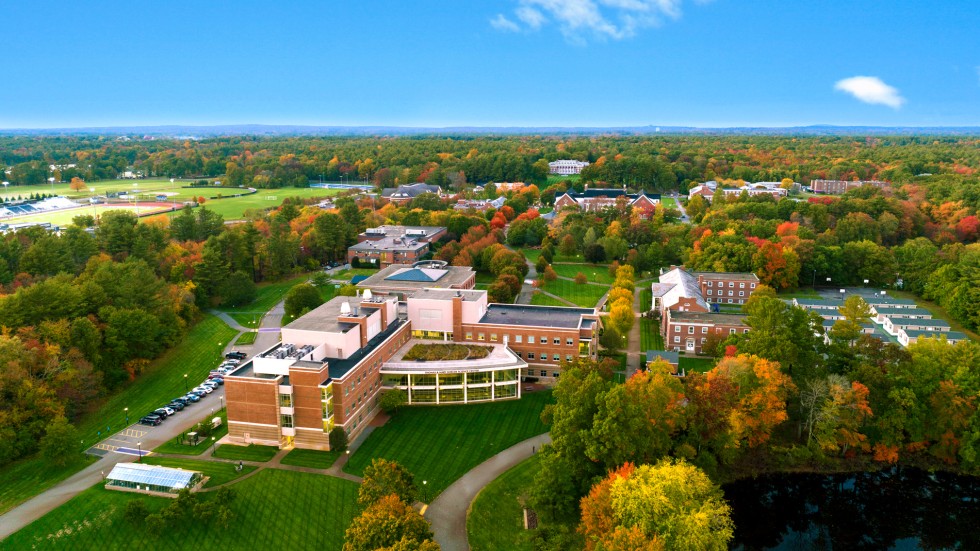2018-2019 Hill Book (Class of 2022) [ARCHIVED HILL BOOK]
Visual and Performing Arts
|
|
 Return to: Programs of Study Return to: Programs of Study
Faculty:
Department Chairperson:
Adam Lampton
Office: Cushing-Martin 030
Phone: 508-565-1954
alampton@stonehill.edu
Professors:
S. Savage-Rumbaugh
Associate Professors:
D. Kinsey
A. Lampton
L. Redpath
C. Walters
Assistant Professors:
J. Bohn
M. Greene
V. Robertson
A. Sheckler
C. Smith Corby
G. Stanton (Sabbatical, Spring 2019)
C. Vallee Morgan
Faculty Fellows:
A. Popa
Carole Calo Gallery Director:
C. Smith Corby
Production Manager and Technical Designer:
J. Petty
The department offers majors in Arts & Visual Culture (with concentrations in Arts Administration, Studio Arts, and Visual Studies), Graphic Design, and Performing Arts (with concentrations in Dance, Music, Theatre, and Cross-Disciplinary Performance). Students have also developed innovative interdisciplinary programs in art and expressive therapies that allow for exploration outside of our traditional majors.
Minors in Art History, Dance, Music, Music Technology, Studio Arts and Theatre Arts are also offered.
Departmental Mission
The Visual and Performing Arts Department provides a variety of courses to enhance students’ Liberal Arts foundation through appreciation of the world’s cultural past and present. Students develop perceptual and analytical skills while exploring the ideological, religious, political, and personal forces that have shaped creative expression throughout the centuries and into today.
In Art History, Music History and Theatre History courses students gain an appreciation for the artistic and musical modes through which artists have grappled with essential aspects of the human condition in various cultures during different historical periods. In Studio, Performance, and Theatre Arts classes, through hands-on study of specific techniques, students explore their own creative potential and its practical application in the wider world.
The Visual and Performing Arts Department seeks to expand the definition of the traditional arts to include art as a social catalyst, to engage students in social service and practical experience through outreach programs and internships. The Visual and Performing Arts majors and minors prepare students for a huge range of graduate work or career possibilities within the creative economy.
Learning Outcomes
Majors with a concentration in Arts Administration will:
- acquire the necessary knowledge and skills for careers in management in cultural institutions including a solid foundation in business.
- develop an understanding of arts organizations such as galleries, museums, and the like and/or performing arts organizations such as concert or theatre venues.
- integrate experiential learning with Arts Administration theory and practice through related internships, both domestic and international, and through the capstone curatorial course, Exhibitions and Collections.
- be directly exposed to professionals in the field through guest lecturers.
Majors with a concentration in Studio Arts will:
- learn to think creatively and holistically.
- develop critical thinking skills.
- work productively in groups and learn teamwork.
- problem solve.
- learn to give and receive criticism gracefully and effectively.
- cultivate their imagination and harness their conceptual abilities.
- learn the fundamental skills and vocabulary of art and of visual communication.
- be exposed to and gain appreciation for a wide variety of artistic practices.
- explore new as well as traditional media.
- create and display a body of creative work.
Majors with a concentration in Visual Studies will:
- understand and employ different art historical methods.
- develop effective communication skills, both written and oral, about art works.
- develop a knowledge of a wide range of art objects from contemporary art through the distant past.
- integrate experiential learning and art historical theory and practice.
Majors in Graphic Design will:
- develop the knowledge, skills, and competencies as well as participate in applied learning experiences that graduate schools and employers seek.
- work successfully as a member of a creative team.
- sharpen visual communication skills.
- accurately gather and process information.
- creatively problem solve.
- develop the skills to produce concepts and visual communication solutions in a variety of media.
- gain knowledge of the different uses of effective, persuasive communication tools to reach and appeal to target audiences.
ProgramsMajorMinor
 Return to: Programs of Study Return to: Programs of Study
|
